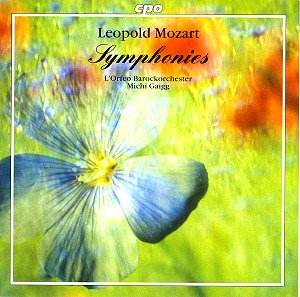Some composers appear
in every book on music history, but
mostly because they have written an
important treatise or have been the
teacher of a famous composer. Johann
Mattheson, Johann Josef Fux and 'Padre'
Giovanni Battista Martini all belong
to this category. Their activities in
composing are mostly referred to, but
hardly explored, or provided with negative
qualifications. Since most of their
works are seldom performed or recorded
it is difficult to verify such negative
assessments.
Leopold Mozart shares
the fate of the aforementioned composers.
He is first and foremost known as father
of Wolfgang Amadeus, and secondly as
author of an important book on playing
the violin. If compositions of his are
performed at all, then mostly it is
the lighter, divertimento-like works.
On the basis of these he is usually
considered a very mediocre composer.
From this perspective
it is rather disappointing that most
compositions selected for this disc
belong to the genre of the divertimento.
These are particularly suitable to support
the existing prejudice of superficiality.
Only the last item on this disc, the
so-called 'Neue Lambacher Sinfonie',
does belong to the more 'serious' type
of orchestral music.
Already in Leopold's
own time his compositions of music for
entertainment met some criticism. After
a performance around the turn of the
year 1755/56 he received an anonymous
letter which said:
"May the gentleman
please not do such farcical pieces
any more, like Chinese and Turkish
music, a sleigh ride, even a peasant
wedding, as it brings more shame
and contempt for your person than
honour, which I as an authority
regret and herewith warn you, I
persist as your dearest friend."
This event reflects
the social development in the 18th century
which underlies the creation of the
kind of music Leopold Mozart and many
of his contemporaries wrote. This is
extensively explained in the booklet.
Traditionally instrumental
music was played in the private circles
of the court or the private rooms of
the upper middle classes by professional
musicians (the circle the writer of
the above-mentioned letter clearly belonged
to). The lower classes didn't have access
to this kind of performance. But their
growing self-consciousness made them
asking for instrumental music to be
played in public. Generally public concerts
were performed by non-professional players.
This created a need for music which
wasn't too technically complicated.
Many pieces were programmatic: this
way the composer could explain the meaning
of his music to performers who were
not able to understand its meaning in
a more theoretical way.
In addition composers
gave often detailed clues as to how
their music should be performed. So
did Leopold Mozart in the first two
pieces on this disc.
In the Sinfonia di
caccia he orders the horns to play 'forte'
all the time. He also asks for barking
dogs and for people yelling 'ho ho'
for five bars.
In the 'Bauernhochzeit'
he wanted hurdy-gurdy and bagpipe to
be added to the strings. They don't
have a part of their own, but they should
come in now and then playing the part
of the violin.
The third work, the
Sinfonia Burlesca, links up with the
popularity of comical characters, known
from the commedia dell'arte, like Arlecchino
and Il Signor Pantalone, or the Austrian
peasant comedy (Hanswurst).
In a way playing this
kind of music isn't easy. The problem
isn't technical, but atmospheric: in
particular on a CD it is difficult to
create the right atmosphere. Several
things Leopold Mozart asks for are ignored
here: there are no barking dogs, no
people screaming 'ho ho', let alone
the shooting of a rifle in the Sinfonia
di caccia. The differentiated playing
of the horns in this work is admirable,
but out of place here. Their playing
is way too polished, and they don't
play 'forte' all the time either.
In the Bauernhochzeit
the hurdy-gurdy and bagpipe are used
and there is some yelling and whistling
but it sounds too laboured and unnatural.
Things like these are useless when the
playing is as neat and humourless as
is the case here.
The Sinfonia Burlesca
doesn't depend that much on effects
and doesn't require too many frills.
There are no parts for violins, and
is played here with 2 violas, 2 cellos,
double bass, bassoon and harpsichord.
The performance is vivid, with clear
articulation, but just a little too
serious.
In the last item we
meet Leopold Mozart as the composer
of 'serious' music, and in this work
he cuts a pretty good figure. It is
telling that for a long time this symphony
has been attributed to Wolfgang Amadeus.
The first movement is very lively and
colourful, with beautiful parts for
the wind. The playing here is very energetic,
with fine dynamic contrasts. The andante's
vivid rhythms are realised very well
and the last movement is enthralling.
The interpretation
as a whole is rather unbalanced. One
really shouldn't listen too carefully
to the first two items as they are meant
simply to entertain. But unfortunately
the performance is too serious to use
these pieces to add to the fun at weddings
and parties. I personally don't expect
to listen to them again. However the
'Neue Lambacher Sinfonie', in particular,
deserves to be played more often. Here
the unmistakable qualities of the orchestra
come through most clearly.
The booklet refers
to the considerable dramatic qualities
of Leopold Mozart's sacred music. Could
we once hear some specimens of that,
please?
Johan van Veen


